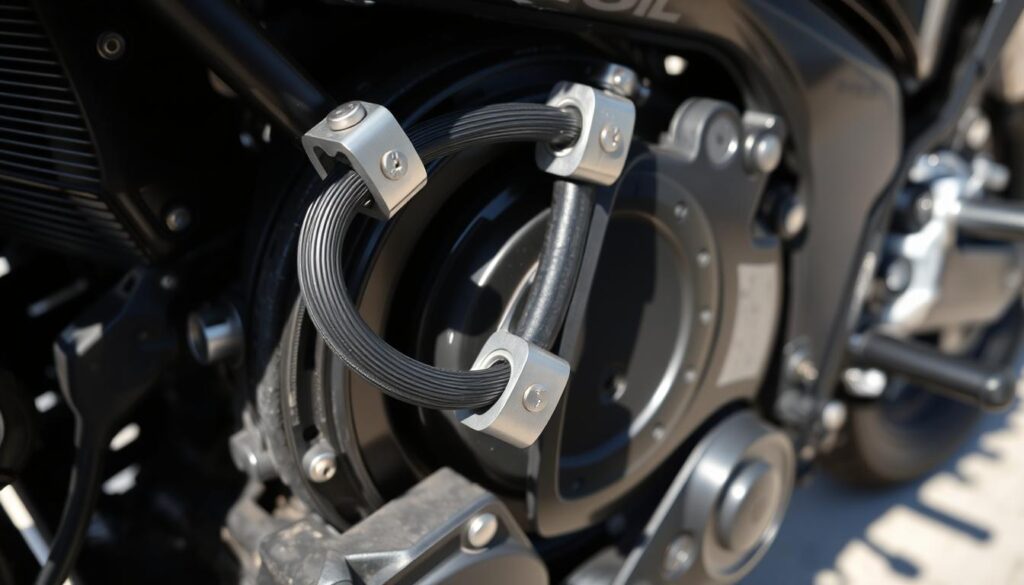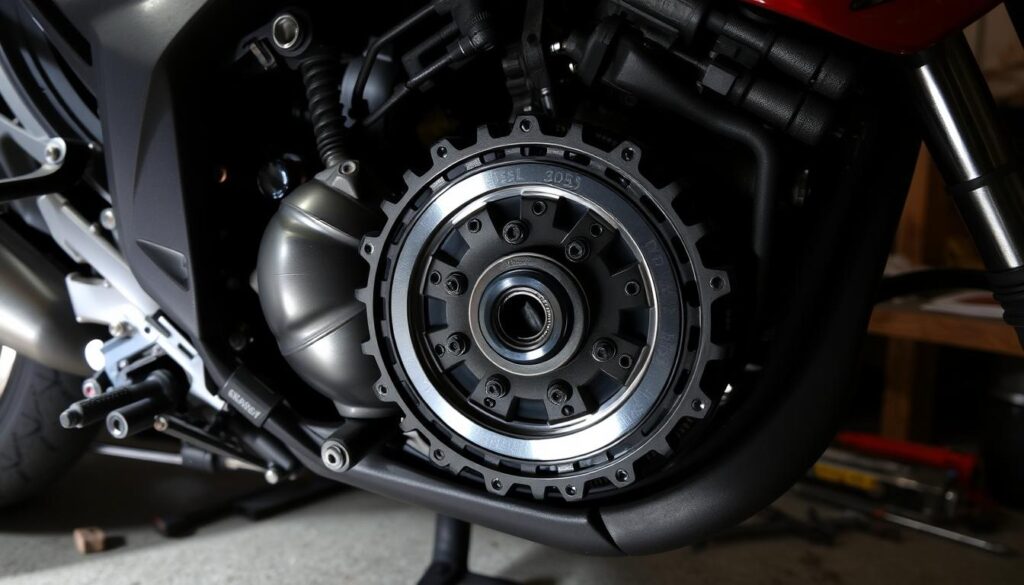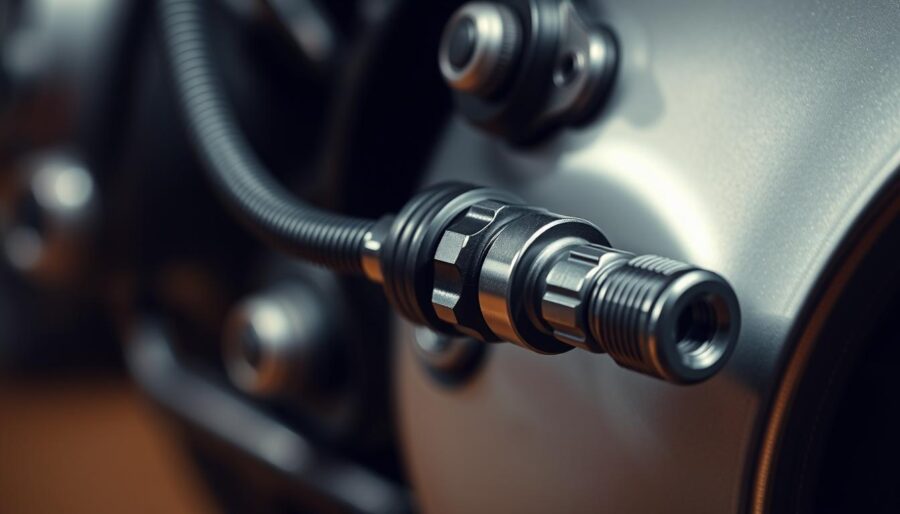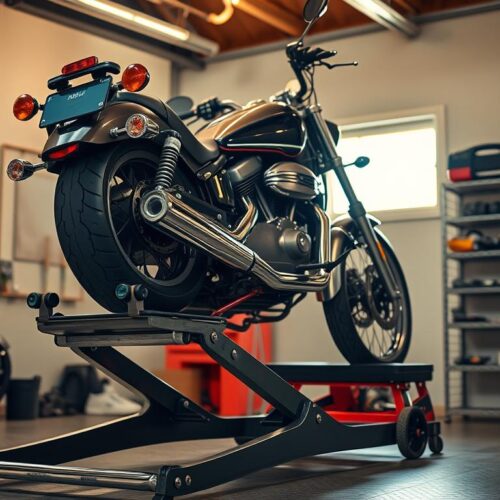Getting the clutch cable adjustment right is key for any biker. It leads to smoother shifting and a better ride. When you know how to adjust your clutch cables the right way, you stop tough shifting and too much wear on your bike’s gears. Manual bikes use cables for clutch control, letting you make adjustments easily. This guide will show you why tuning your clutch cable matters for taking care of your bike.
Understanding the Importance of Clutch Cable Adjustment
Adjusting the clutch cable right is key for the best clutch performance on your bike. A wrong adjustment can lead to safety and comfort issues while riding. If the cable is too loose, it might not fully engage. This can cause slippage and wear out the transmission faster.
It could also make shifting gears hard or even make the motorcycle stall. On the flip side, if the clutch cable is too tight, fully engaging the clutch will be tough. This makes changing gears smoothly hard and controlling the motorcycle harder. For smooth shifting and better rides, keep the slack between 3 to 5 mm when you maintain your bike.
Adjusting the clutch cable regularly helps your motorcycle perform better and last longer. This simple step can prevent bigger problems later, making your rides safer and more joyful.
Tools You’ll Need for the Job
Before you start adjusting your clutch cable, you need to gather the right tools. Having the necessary tools makes the job easier and faster.
Here’s what you’ll need:
- Socket set
- Adjustable wrench
- Pliers
- Vernier caliper or tape measure
- Cable lubricant
- Rags for cleaning
The size of the spanners you need might change based on your bike. Usually, you’ll need sizes like 10mm, 11mm, 12mm, and 14mm. With the correct tools, fixing your clutch cable becomes simpler and quicker.
Locating Your Motorcycle’s Clutch Cable
Finding where the clutch cable is on your motorcycle is key for proper tuning. The cable goes from the handlebar lever to the engine’s clutch mechanism. This connection is vital for your bike’s operations.
To see the clutch cable better, move back any rubber covers on its ends. Knowing how it’s laid out helps with fixes and noticing clutch issues sooner.
| Component | Location | Function |
|---|---|---|
| Clutch Lever | Handlebars | Controls the engagement and disengagement of the clutch |
| Clutch Cable | Along the frame | Transmits force from the lever to the clutch mechanism |
| Clutch Mechanism | Near the engine | Engages and disengages the engine power to the gearbox |

How to Check Clutch Cable Slack
Start by pulling the clutch lever to check its movement. You’re aiming for 3 to 5 mm of free play. It’s important to measure accurately for the best outcome. You can use a vernier caliper or a ruler.
If your clutch slack isn’t in this range, you’ll need to adjust it. Use the barrel adjuster for easy tension changes. Turn it clockwise to add slack. Turn it counter-clockwise to reduce slack, aiming for the right measurement.
Here’s a quick reference table showing the ideal clutch cable slack measurements:
| Measurement | Recommended Range |
|---|---|
| Clutch Free Play | 3 to 5 mm |
Steps for Adjusting the Clutch Cable
Adjusting your bike’s clutch cable makes sure your gears shift smoothly and your bike runs well. First, loosen the lock nut on the adjustment barrel. This is key for making more adjustments to how tight the cable is.
To adjust tension, turn the adjustment knob counter-clockwise. This makes the cable longer and less tight, which is good if your clutch feels too tight. Make sure you follow these steps precisely to keep everything working right.
After adjusting, tighten the lock nut well. Then, check the slack again to make sure it is in the suggested range. Testing the clutch lever will show if it works smoothly. Keeping up with your bike, like adjusting the clutch cable, is important for a good ride and keeping your bike running great.
Common Mistakes to Avoid
It’s important to focus on the details when adjusting your clutch. A big mistake is when the clutch cable gets too tight. This can make the clutch slip at high RPMs, causing your ride to be uneven. Also, not checking the cable for wear and tear is a mistake. If overlooked, the cable might fail and leave you stuck.
To keep away from mistakes with the clutch cable, adjust it slowly. If you pull it too tight, it can be hard to fix. Make sure to check your cable often, as part of keeping your bike running well. Paying attention during the adjustment means a better ride.

Testing Your Adjustment
After you adjust the clutch cable, it’s important to test it out. Start your motorcycle and let the engine heat up. Then, while riding, use the clutch to see how it performs.
When you’re checking the clutch’s performance, notice how the bike shifts gears. A cable that’s adjusted right makes shifting smooth, without trouble. If shifting feels hard, you might need to adjust it more.
| Observation | Action |
|---|---|
| Difficulty shifting gears | Recheck clutch cable adjustment |
| Clutch feels too loose or too tight | Adjust cable slack accordingly |
| Resistance while shifting | Inspect for cable binding |
| Clutch slips | Consider possible cable replacement |
Following these steps ensures your bike will shift smoothly. If you still have trouble, it might be time to get help from a pro.
When to Seek Professional Help
It’s usually okay to adjust your motorcycle’s clutch cable yourself. But sometimes, things might get complicated, making it wise to call an expert. If your clutch lever starts to feel too tight or too loose, that’s a hint you might need help. Using it like that could make things worse.
Also, if you notice any clear damage to the cable, getting a professional’s opinion is essential. Catching these issues early can prevent bigger, costlier repairs later on. A skilled mechanic can check your motorcycle carefully and fix it right, helping it last longer and run better.
Maintenance Tips for Your Clutch Cable
Keeping your clutch cable in top shape is key for good motorcycle performance. You should check it regularly for fraying or damage signs. Look closely at the cable and where it connects to other parts. Fixing these issues early helps avoid bigger problems later.
It’s important to lubricate your clutch cable every few months. This is especially true if you ride a lot in bad weather. Lubrication helps the cable work better, lasts longer, and prevents rust. It also makes your motorcycle respond faster.
Over time, you may need to adjust your clutch cable. Make it a routine to check its slack and adjust when necessary. Keeping up with these maintenance tasks helps your motorcycle run well. It also makes riding more enjoyable.
Understanding Clutch Cable Replacement
The state of your bike’s clutch cable is key for smooth rides. It’s important to know when it’s time for a new one to prevent breakdowns. If you see fraying or damage, get ready to replace it. Regular checks keep your ride safe and performing well.
First, assess the cable. Look for stiffness or cracks. These signs mean you need a new cable. Getting the right parts for your bike is crucial. Your bike’s manual has the specs you need to find the right fit.
Follow the guidelines from the manufacturer to install it correctly. The right fitting and adjustments will help your bike run better for longer. By knowing when to swap the clutch cable, you avoid bigger problems later.
Conclusion: Enjoying a Smooth Ride
Understanding how to adjust your motorcycle’s clutch cable is key to a better ride. When the clutch cable is set right, you get smooth shifts. This makes riding not just more fun but also safer.
Adjusting your clutch right also helps your clutch parts last longer. Keeping up with this maintenance means your bike works its best. This care makes for a ride you can rely on and enjoy, focusing on the road ahead.
Follow the given tips to keep your clutch cable in top shape. By doing regular checks and adjustments, you’ll get smoother shifts. This leads to the best riding experience every time you hit the road.




